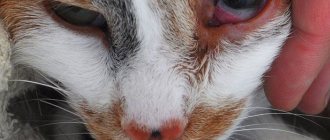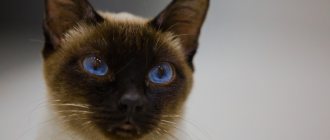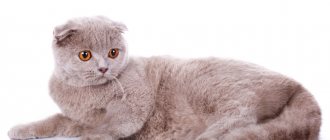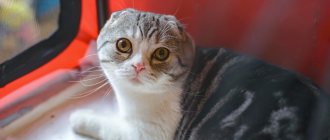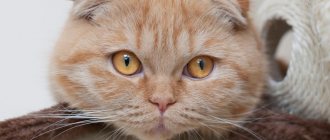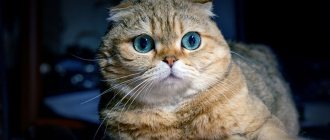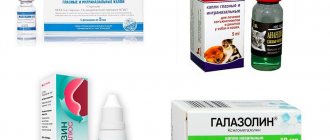Owners of Scottish cats often notice lacrimation in the animal.
Often the owner decides that this is a disease and begins to treat the pet. Before you take any action, you need to determine why your Scottish Fold cat's eyes are watering.
This usually occurs as a result of physiological factors, but sometimes the development of a symptom can trigger a serious illness.
It is necessary to distinguish normal discharge from the eyes from pathological ones. At the same time, the general condition of the animal, the nature and intensity of lacrimation, and the presence of accompanying signs are assessed.
The eye discharge in a kitten is different from that of an adult animal.
The choice of methods to eliminate this problem depends on the cause that provoked the development of the problem. In case of a pathological process, the veterinarian prescribes eye treatment products, which can be purchased at a regular or veterinary pharmacy.
Manifestations of pathology
Before treatment, the animal’s condition should be assessed, so pay attention to the duration and nature of eye discharge, the presence or absence of other symptoms.
Signs may be as follows:
profuse lacrimation;- swelling around the eyes;
- brown, green and yellow discharge;
- impurities of pus in the discharge.
A Scot with pathology may constantly rub his eyes.
In some cases, symptoms include:
- hyperthermia;
- copious nasal discharge;
- drowsiness;
- changes in habitual behavior;
- apathy;
- pet anxiety;
- cough.
If symptoms appear that are not normal, you should consult your veterinarian.
Allergy
There are many reasons for its appearance: plant pollen, household chemicals (sprays, shampoos, anthelmintic drugs, etc.), mold, cigarette smoke, etc. The main signs: coughing or sneezing, itching (the cat is itching), watery eyes, runny nose. Possible vomiting and diarrhea. The cause of the allergy will be determined by your veterinarian. He will prescribe treatment. If you already know what exactly your cat reacts to, it will be easier to deal with the problem. If, for example, the animal does not tolerate chicken, eliminate everything that contains fat and protein (chicken).
Allergic reactions can occur to fleas or helminths, or to treatment with certain medications (most often antibiotics).
Breed Features
Discharge in the form of tears is considered a feature of the breed.
The Scottish Fold cat has an unusual eye structure. The animal's skull is not the same shape as that of other breeds, as a result of which there is a narrowing of the tear ducts.
In a normal cat, the nasolacrimal ducts are wide, so secretions pass through them. In a Scotsman, due to the narrowing of the passages, tears flow out of the eyes. This is especially noticeable after the cat wakes up.
Main reasons
Experts identify many factors that cause lacrimation in a pet.
Most often, pathology occurs due to the following reasons:
entry of a foreign body into an organ;- helminthic infestations;
- structural features of the head;
- allergic reaction to certain products;
- improper care of your pet;
- infectious diseases;
- eye injury.
If these reasons provoke lacrimation in a cat, then drug treatment is used.
Physiological reasons
If a symptom has developed as a result of physiological factors, eye treatment does not need to be performed.
These reasons include:
breed characteristics;- discharge from the eyes after eating;
- after waking up.
Light from fluorescent lamps is also considered a physiological reason for the development of this phenomenon: bright lighting irritates the eyes, and discharge begins to flow from them.
Disease provocateurs
Watery eyes are often caused by various diseases. The following infections can provoke a pathological phenomenon:
- chlamydia;
- herpes;
- rhinotracheitis of viral etiology.
Your cat may have other problems caused by pathogens.
Their symptom may also be bleeding from the eyes. A pathological phenomenon sometimes indicates conjunctivitis, the causative agents of which are viruses or bacteria .
Tears may be a sign of respiratory disease. In this case, the Scot will suffer from other symptoms, for example, hyperthermia, cough, runny nose, and his general condition worsens.
Infections
Viruses and bacteria often cause excessive tearing. Some of them are difficult to treat (for example, panleukopenia). Some diseases are transmitted to people (mycoplasmosis, chlamydia, herpes, etc.).
Diagnosis is required to determine the disease. According to veterinarian statistics, chronic conjunctivitis (long-term inflammation of the eye mucosa) is most often detected. Such animals require a thorough ophthalmological examination with the Schirmer test (to confirm or exclude creatitis), determination of eye pressure (possible glaucoma), etc. The appendages of the eyes must be examined for eyelid abnormalities.
In case of mucopurulent discharge, a test for the sensitivity of the microflora to antibiotics will most likely be required. The analysis is done before washing the eyes or using any medicinal substances (drops, ointments), which will certainly distort the results by reducing the concentration of bacteria or slowing down their reproduction. necessary for the diagnosis of eosinophilic or allergic conjunctivitis. Infection is indicated by altered neutrophils (a consequence of the work of bacterial cells). Sometimes viral bodies (intracellular inclusions) and chlamydia are detected.
An infection can be ruled out by washing the conjunctiva for rhinotracheitis, mycoplasmosis, and chlamydia. If the tests come back negative, you should consider an ophthalmological examination.
Pathology or not
If a cat’s eyes are running, this phenomenon may be normal or indicate a pathological process.
In case of various diseases in a pet, the discharge is characterized by an unusual color (yellow, transparent, red, brown, green). In pathology, tears flow heavily, the eyes are slightly swollen, and the animal constantly rubs them. Sometimes the cat cannot open them completely.
The British man's eyes are watering - is it pathological or not? This question can be answered only after assessing the condition of the animal, the nature of the discharge and other factors.
Discharge rate
In cats of this breed, discharge is considered normal if:
they are transparent;- not very abundant;
- occur after sleep.
In this case, there is no need to treat the animal. This is a normal process in British breed cats.
Vaccination of Scottish Fold cats
Vaccination is one of the first preventive measures for animals. The risk of developing the disease with timely vaccinations decreases significantly. The doctor chooses a set of medications based on the living conditions.
The first vaccine (usually complex or rabies) is given after 1.5 months, but no later than 2.5 months. You will need to come back for a second vaccination in six months. Upon reaching 12 months, vaccination is carried out annually at regular intervals. Before a year, medications for rhinotracheitis, microsporia, panleukopenia, calicivirus and calicivirosis must be supplied.
The offspring of a vaccinated cat, subject to mating rules, provides an increased level of immunity. Depending on the date of the mother's last vaccination, the baby's first vaccination may be delayed by 12 weeks. If there is no information about the cat, it is better not to delay the procedure beyond 8 weeks.
Offspring from a vaccinated cat, subject to mating rules, provides an increased level of immunity
Important! When feeding, the cat gives the babies a lot of energy and internal resources, forming their immunity. The mother cannot be vaccinated annually until her body is restored. Kittens are excluded from the procedure during the period of age-related changes in the dentition.
The procedure requires preparation:
- general inspection. The pet must have normal body temperature, no signs of any diseases, and be active;
- studying the vaccination card. The doctor should know what medications have already been given. Some of them are needed only once in a lifetime;
- deworming. The vaccine can provoke massive death of parasites in the body, which will lead to severe poisoning;
- eliminating other medications a week before vaccination to avoid unwanted reactions. If the animal takes medications regularly, it is necessary to notify the doctor in advance.
Veterinarians constantly remind that even a domestic cat without outdoor walking needs disease prevention. The virus can come randomly from food, a person’s clothing, a toy, or water.
Vaccination scheme
Advice. After the first vaccination, you should ask your doctor for a vaccination schedule for your Scottish cat. The dates and types of recommended medications are indicated there.
No vaccine provides 100% protection against the disease, but it significantly reduces the risk of severe forms.
Features of pathology in kittens
Kittens of this breed can also be a bit teary. However, these discharges are detected only after the pet wakes up. Normally they almost never happen.
But a veterinarian will definitely be needed when the kitten has a brown or yellow-green tinge to the eye discharge. A specialist should show the animal if the eyelids are swollen or if there is excessive lacrimation.
Provoking factors in small kittens include:
intrauterine infection;- lack of vaccinations;
- congestion of the tear ducts;
- weak immune system.
If a kitten has a little clear discharge after sleep, and its eyes sparkle, then these are not pathological processes.
Therapy methods
Treatment primarily depends on the underlying cause of your cat's watery eyes. If the phenomenon is provoked by a physiological factor and a peculiarity of the breed, then the pet’s eyes should not be treated.
At home, when the disease develops, the following remedies are used to treat the eyes:
- tetracycline ointment;
- Levomycetin drops;
- Furacilin;
- Sulfacyl sodium;
- Albucid;
- solution of potassium permanganate (weak).
The veterinary pharmacy sells special medications.
The following drugs are considered effective:
- Diamond eyes;
- Phytoelite;
- Iris.
To treat your eyes, you need to wipe them with cotton wool in the direction from the outer to the inner corner.
If medications used for 2-3 days are ineffective, the cat needs to be shown to a specialist .
In addition to eye treatment, treatment should be aimed at eliminating the underlying cause that caused this symptom.
If the pathology is caused by worms, anthelmintic drugs are used. Antibacterial agents are used for various infections. Watery eyes caused by allergies are treated with antiallergic medications.
Traditional methods of treatment
What to do if you don’t have any medications on hand, and your cat’s eyes are watering? In this case, traditional therapy recipes are used. These include decoctions of medicinal plants.
Herbs used are:
chamomile;- marigold;
- calendula;
- green tea;
- sage;
- St. John's wort.
They help eliminate crusts containing pus after the cat wakes up, relieve the inflammatory process, and inhibit the growth and reproduction of pathogens.
Eye injuries
Sometimes cat owners try to dig deep in an attempt to find out the cause of the problem, but it lies on the surface. The cat simply injured his eye or something got in there. Take a closer look, preferably in good daylight. Do you see any problems on the cornea? If you see that some foreign object (lint, wool, soil) is in the eye, under no circumstances start picking it out with your finger or cotton wool: you can seriously injure the eye. Moreover, Scottish cats have bulging eyes - it is very easy to cause injury. It’s better to rinse your eyes so that the lint comes out on its own.
How to wash the eyes of a Scottish kitten or a cat of any other breed? To do this, prepare lukewarm purified or boiled water or a decoction of chamomile, sage, calendula, St. John's wort, tea. Pour the liquid into a small container and throw in a few cotton pads (never an ordinary cotton pad, otherwise you risk giving your eye new lint). Before wetting, pat the discs so that there is no lint on them. Next, lay or sit the cat so that its eyes are turned upward. It is advisable to do this together: one holds, the other rinses. The task of the one who holds is to make sure that the cat does not twitch and that his eyes are turned upward. The task of the person who is dripping is to very carefully part the eyelids (not too much), take a slightly squeezed cotton pad and squeeze the liquid into the eye. If you have a clean dropper in the house, it is better to use it. After instillation, the cat will reflexively close its eyes, let him do this. The main thing is that the liquid gets into the eye initially. Repeat the procedure 2-3 times until the desired effect is achieved.
If there is some kind of hard foreign object in the cat’s eyes that you can’t just wash off, then this is a reason to urgently seek help from a veterinarian.
Prevention measures
To prevent lacrimation, you must follow the following prevention rules:
- Properly care for your cat.
- Carry out antiparasitic treatment regularly.
- Vaccinate the animal in a timely manner.
Prevent the development of infectious diseases.- Make a complete and rational diet for your cat.
- Strengthen the animal's immune system.
- Make sure that no foreign objects get into your pet's eyesight.
For prevention, you can treat your cat's eyes with chamomile infusion.
